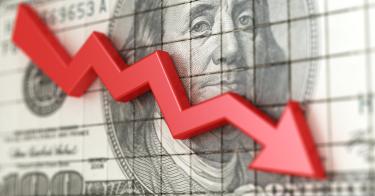With the appropriations fight in Washington in overdrive, and a barely avoided government shutdown behind it—for now—Congress should be paying attention to the latest economic data now more than ever. Recent revisions show things are actually worse than previously estimated.
In fact, both the American consumer and the federal budget will soon be at the breaking point if Congress doesn’t rein in spending immediately.
The recent comprehensive update to gross domestic product (GDP) by the Bureau of Economic Analysis revised data going back several years. It turns out that when President Donald Trump left office, the economy was growing faster than previously estimated, 4.2 percent versus 3.9 percent. Conversely, the data for President Joe Biden’s tenure has been revised down.
Under Biden, economic growth was revised down in four quarters, just two quarters were revised up, and four were unchanged. Meanwhile, the recession in the first half of 2022 was worse than previously estimated. Not everything was revised down, however—inflation was revised up, meaning prices have been rising even faster than the government said they were.
>>> Bidenomics Is Postponing Americans’ Retirement Dreams for Years
During Biden’s tenure, inflation data was revised up for seven quarters, down for two quarters, and one quarter was unchanged. Also revised up was government spending, which has now grown faster than consumer spending in each of the last four quarters.
In short, growth in government spending is crowding out the private economy, slowing growth, accelerating inflation, and making people worse off. This new data should be a wakeup call for Congress to the nation’s financial plight.
Government spending has become an albatross around the neck of the American economy. The big spenders in Washington got addicted to the low interest rates orchestrated by the Federal Reserve for over two decades and they borrowed trillions of dollars, never considering that interest rates might rise one day.
With a federal debt of over $33 trillion, the impact of interest rates on federal finances is significant. At low rates, annual financing costs on that much debt are about $600 billion. While that’s nothing to sneeze at, it’s a relatively small portion of the roughly $3 trillion in annual federal revenues.
But that calculus changes radically with today’s higher interest rates. Just refinancing the existing debt at these higher rates, without any additional borrowing, will cause financing costs to explode, reaching $1.7 trillion. That’s more than half of federal revenues.
This is like a family being in so much credit card debt that over half of the family’s income is used to pay finance charges on those credit cards, without a single cent going towards paying down the credit-card debt.
That’s where America is headed. Every day that goes by, more of the existing federal debt is maturing and being refinanced, shifting from a low interest rate to a higher one. On top of the old debt being rolled over, the Treasury is also constantly issuing new debt to finance Congress’ runaway spending, and this new debt is also being issued at higher interest rates.
>>> China’s Economic Collapse Carries a Warning About Our Own Future
The nation’s current fiscal trajectory is unsustainable. Interest on the debt is already the third-biggest line item in the Fiscal Service’s monthly Treasury statement. In less than a decade, it will eclipse whole categories like defense, education, and social security—combined. With tax revenues already near record highs, the only solution is to reduce government spending.
While the lowering of interest rates appears to be an alternative solution, this isn’t possible with the current levels of government spending and borrowing. The only way the Treasury can attract savers to lend it the trillions of dollars it needs is if it offers to pay higher interest rates.
If the Federal Reserve artificially pushes interest rates back down, it will reignite inflation. And even that will only work in the short term. Once savers see that inflation is going higher, they will demand higher interest rates from the Treasury to compensate for their lost purchasing power.
Congress needs to take this situation seriously and drastically curtail spending. The current appropriations fight is the perfect opportunity to put America back on a path to fiscal sanity. Failing to do so at this late stage just might lose the last chance we have to turn this battleship around.
Eventually, your momentum will take you over the falls. Let’s hope Congress acts before it gets that far.
This piece originally appeared in MSN




